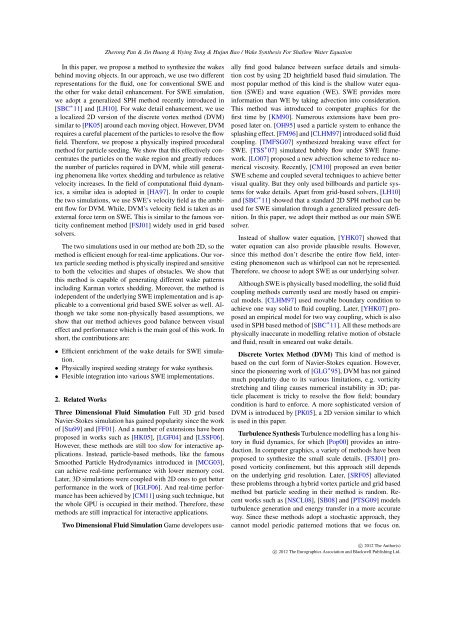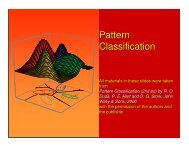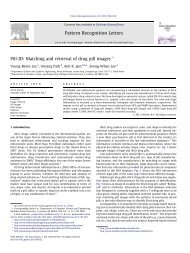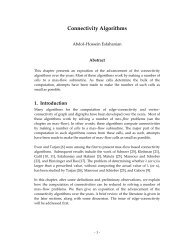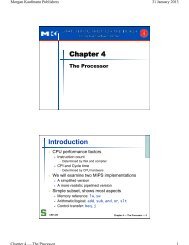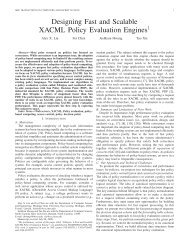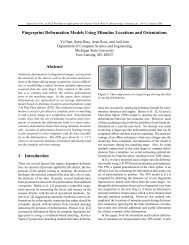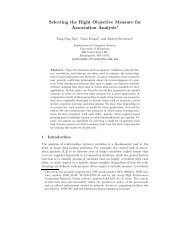Wake Synthesis For Shallow Water Equation - Department of ...
Wake Synthesis For Shallow Water Equation - Department of ...
Wake Synthesis For Shallow Water Equation - Department of ...
You also want an ePaper? Increase the reach of your titles
YUMPU automatically turns print PDFs into web optimized ePapers that Google loves.
Zherong Pan & Jin Huang & Yiying Tong & Hujun Bao / <strong>Wake</strong> <strong>Synthesis</strong> <strong>For</strong> <strong>Shallow</strong> <strong>Water</strong> <strong>Equation</strong><br />
In this paper, we propose a method to synthesize the wakes<br />
behind moving objects. In our approach, we use two different<br />
representations for the fluid, one for conventional SWE and<br />
the other for wake detail enhancement. <strong>For</strong> SWE simulation,<br />
we adopt a generalized SPH method recently introduced in<br />
[SBC ∗ 11] and [LH10]. <strong>For</strong> wake detail enhancement, we use<br />
a localized 2D version <strong>of</strong> the discrete vortex method (DVM)<br />
similar to [PK05] around each moving object. However, DVM<br />
requires a careful placement <strong>of</strong> the particles to resolve the flow<br />
field. Therefore, we propose a physically inspired procedural<br />
method for particle seeding. We show that this effectively concentrates<br />
the particles on the wake region and greatly reduces<br />
the number <strong>of</strong> particles required in DVM, while still generating<br />
phenomena like vortex shedding and turbulence as relative<br />
velocity increases. In the field <strong>of</strong> computational fluid dynamics,<br />
a similar idea is adopted in [HA97]. In order to couple<br />
the two simulations, we use SWE’s velocity field as the ambient<br />
flow for DVM. While, DVM’s velocity field is taken as an<br />
external force term on SWE. This is similar to the famous vorticity<br />
confinement method [FSJ01] widely used in grid based<br />
solvers.<br />
The two simulations used in our method are both 2D, so the<br />
method is efficient enough for real-time applications. Our vortex<br />
particle seeding method is physically inspired and sensitive<br />
to both the velocities and shapes <strong>of</strong> obstacles. We show that<br />
this method is capable <strong>of</strong> generating different wake patterns<br />
including Karman vortex shedding. Moreover, the method is<br />
independent <strong>of</strong> the underlying SWE implementation and is applicable<br />
to a conventional grid based SWE solver as well. Although<br />
we take some non-physically based assumptions, we<br />
show that our method achieves good balance between visual<br />
effect and performance which is the main goal <strong>of</strong> this work. In<br />
short, the contributions are:<br />
• Efficient enrichment <strong>of</strong> the wake details for SWE simulation.<br />
• Physically inspired seeding strategy for wake synthesis.<br />
• Flexible integration into various SWE implementations.<br />
2. Related Works<br />
Three Dimensional Fluid Simulation Full 3D grid based<br />
Navier-Stokes simulation has gained popularity since the work<br />
<strong>of</strong> [Sta99] and [FF01]. And a number <strong>of</strong> extensions have been<br />
proposed in works such as [HK05], [LGF04] and [LSSF06].<br />
However, these methods are still too slow for interactive applications.<br />
Instead, particle-based methods, like the famous<br />
Smoothed Particle Hydrodynamics introduced in [MCG03],<br />
can achieve real-time performance with lower memory cost.<br />
Later, 3D simulations were coupled with 2D ones to get better<br />
performance in the work <strong>of</strong> [IGLF06]. And real-time performance<br />
has been achieved by [CM11] using such technique, but<br />
the whole GPU is occupied in their method. Therefore, these<br />
methods are still impractical for interactive applications.<br />
Two Dimensional Fluid Simulation Game developers usually<br />
find good balance between surface details and simulation<br />
cost by using 2D heightfield based fluid simulation. The<br />
most popular method <strong>of</strong> this kind is the shallow water equation<br />
(SWE) and wave equation (WE). SWE provides more<br />
information than WE by taking advection into consideration.<br />
This method was introduced to computer graphics for the<br />
first time by [KM90]. Numerous extensions have been proposed<br />
later on. [OH95] used a particle system to enhance the<br />
splashing effect. [FM96] and [CLHM97] introduced solid fluid<br />
coupling. [TMFSG07] synthesized breaking wave effect for<br />
SWE. [TSS ∗ 07] simulated bubbly flow under SWE framework.<br />
[LO07] proposed a new advection scheme to reduce numerical<br />
viscosity. Recently, [CM10] proposed an even better<br />
SWE scheme and coupled several techniques to achieve better<br />
visual quality. But they only used billboards and particle systems<br />
for wake details. Apart from grid-based solvers, [LH10]<br />
and [SBC ∗ 11] showed that a standard 2D SPH method can be<br />
used for SWE simulation through a generalized pressure definition.<br />
In this paper, we adopt their method as our main SWE<br />
solver.<br />
Instead <strong>of</strong> shallow water equation, [YHK07] showed that<br />
water equation can also provide plausible results. However,<br />
since this method don’t describe the entire flow field, interesting<br />
phenomenon such as whirlpool can not be represented.<br />
Therefore, we choose to adopt SWE as our underlying solver.<br />
Although SWE is physically based modelling, the solid fluid<br />
coupling methods currently used are mostly based on empirical<br />
models. [CLHM97] used movable boundary condition to<br />
achieve one way solid to fluid coupling. Later, [YHK07] proposed<br />
an empirical model for two way coupling, which is also<br />
used in SPH based method <strong>of</strong> [SBC ∗ 11]. All these methods are<br />
physically inaccurate in modelling relative motion <strong>of</strong> obstacle<br />
and fluid, result in smeared out wake details.<br />
Discrete Vortex Method (DVM) This kind <strong>of</strong> method is<br />
based on the curl form <strong>of</strong> Navier-Stokes equation. However,<br />
since the pioneering work <strong>of</strong> [GLG ∗ 95], DVM has not gained<br />
much popularity due to its various limitations, e.g. vorticity<br />
stretching and tiling causes numerical instability in 3D; particle<br />
placement is tricky to resolve the flow field; boundary<br />
condition is hard to enforce. A more sophisticated version <strong>of</strong><br />
DVM is introduced by [PK05], a 2D version similar to which<br />
is used in this paper.<br />
Turbulence <strong>Synthesis</strong> Turbulence modelling has a long history<br />
in fluid dynamics, for which [Pop00] provides an introduction.<br />
In computer graphics, a variety <strong>of</strong> methods have been<br />
proposed to synthesize the small scale details. [FSJ01] proposed<br />
vorticity confinement, but this approach still depends<br />
on the underlying grid resolution. Later, [SRF05] alleviated<br />
these problems through a hybrid vortex particle and grid based<br />
method but particle seeding in their method is random. Recent<br />
works such as [NSCL08], [SB08] and [PTSG09] models<br />
turbulence generation and energy transfer in a more accurate<br />
way. Since these methods adopt a stochastic approach, they<br />
cannot model periodic patterned motions that we focus on.<br />
c○ 2012 The Author(s)<br />
c○ 2012 The Eurographics Association and Blackwell Publishing Ltd.


